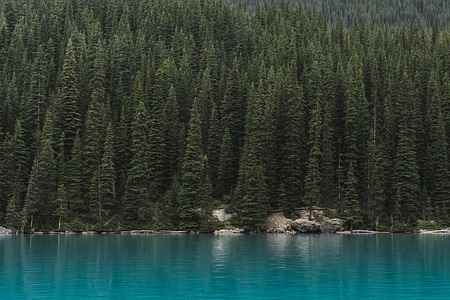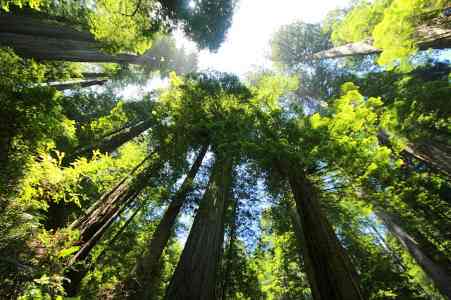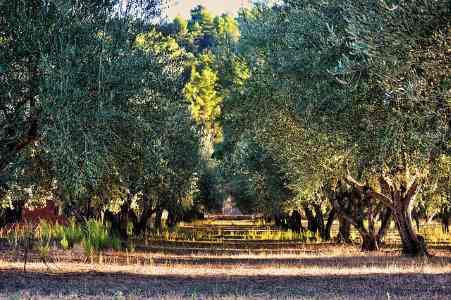The earth’s ecosystem relies on tropical, temperate, and boreal woods all over the globe. Forests are vast areas dominated by trees that have their own ecosystem called a biome. Forests cover approximately 30% of all land on the planet, according to estimates. Evergreen conifers, broad-leafed deciduous trees, or a combination of these tree types may be found in these dense woodlands.
The following are the three primary forest biomes:
- South America, Central Africa, and Southeast Asia are all home to tropical rainforests.
- North America, Europe, and East Asia are all home to temperate woods.
- The taiga, which covers the frigid parts of northern Russia, Scandinavia, and Canada, is another name for the Boreal forest.
There are numerous subcategories within the three primary forest zones. Tropical rainforests, for example, might be damp (as in the tropics) or dry (as in Central America and India). Temperate tropical woods or mixed broadleaf and evergreen woods may also be found on some coastal regions. You’ll learn about a variety of different forest types in this article. In these crucial wooded regions, you’ll learn about the flora, wildlife, and tree varieties.
Types of Forests
Among the most significant terrestrial ecosystems on earth is the forest biome. Forests host thousands of animal and plant species, in addition to storing carbon and providing oxygen.
Tropical Forests

Being near the equator and having a dry and rainy season, tropical forests are diverse and include several distinct forest types.
Tropical Rainforest
Brazil, Peru, the Philippines, Indonesia, Cameroon, and Sri Lanka are among the countries where tropical rainforests may be found. The temperature ranges from 20 to 30°C (68 to 86°F) throughout the year. Rain is a typical feature of these forest types, with an average annual rainfall of 80 inches (200 cm). Tall palms reaching up to 115 feet (35 meters) with a thick canopy (overstory) are typical of tropical rainforests.
A wide variety of trees, plants, and animals call this damp forest environment home. In tropical rain forests, it is believed that approximately 300 different species of deciduous trees exist. Because it supports a wide range of animal species, the tropical rainforest biome is crucial. Exotic birds, snakes, lizards, frogs, monkeys, and huge cats can all be found in the rainforests.
Subtropical Forests
To the north and south of tropical woods, subtropical woods may be found. It’s difficult to tell apart certain humid broadleaf deciduous woods from tropical rainforests. Tropical and subtropical wet woods are thought to harbor more animal and plant species than any other terrestrial habitat, according to estimates.
South America, Central America, Central Africa, and Asia are all home to subtropical deciduous woods. These woods are home to a variety of evergreen and semi-evergreen deciduous trees due to their typically hot, humid climates. Rainy seasons and dry months are part of the subtropical forest’s life cycle. In subtropical areas, coniferous woods with pines and conifers flourish. Central America, Asia, and India are all home to these.
Dry Tropical Forest (Deciduous)
During the dry season, tropical dry forests are typically dominated by deciduous trees that drop their leaves. It is the lack of rainfall that causes trees in tropical regions to lose their leaves, unlike broadleaf forests in temperate climates that do so throughout the winter.
Hardwood tropical trees, such as teak and ebony, can store moisture in this way. Tropical dry woods are more often evergreen in nations such as Thailand, Vietnam, Sri Lanka, and Cambodia.
Because they get enough rainfall throughout the year to avoid leaf fall, this is the case. Elephants, tigers, rhinoceros, giraffes, and leopards are among the animals that live in the dry tropical forest biome. These woods, like tropical rainforests, are home to a variety of tropical birds, big cats, monkeys, and parrots.
Seasonal Tropical Forests
Seasonal woods may be found in several nations across the tropical and subtropical zones. Deciduous trees make up the majority of these woods, which are semi-evergreen. Summers are wet, while winters are dry in seasonal tropical forests. During the wet season, several of these regions are also visited by monsoons. Around the equator, there are seasonal tropical woods that may be found next to rainforests.
Montane (Cloud Forests)

Cloud forests are also a forest biome found in highland tropical regions, and they are constantly covered by low-level cloud. These forests are covered in perpetual fog, giving them a damp, creepy look. Their name implies as much. In the tropics, montane forests may be found in hilly areas.
In this scenario, clouds usually form at canopy height, and the forest environment is frequently misty or foggy. Cloud forests are generally known for their rich array of ferns and mosses on the forest floor due to the moist environment and lack of sunlight.
Trees in cloud rainforests are more stocky and twisted rather than tall and straight, which is one of their characteristics. There are plant species that only grow in cloud forests due to the unique growing environment. Orchids, shrubs, and unique plants like insect-eating plants are all examples of types of orchids. Cloud forest habitats are home to a variety of animals that are unique. The mountain gorilla, for example, is an endangered species in Central African cloud rainforests.
Coniferous Tropical Forests

In tropical and subtropical climates, coniferous tropical woods predominate in North and Central America. The Philippines, India, Pakistan, Nepal, Nicaragua, and Belize are some of the other tropical nations with coniferous forests. The pine trees (Pinus) and conifers that have evolved to thrive in warm, damp climates make up the majority of these forests.
The lack of sunlight on the forest floor, like in other thick tropical forests, allows ferns to thrive. Many migrating butterflies and birds prefer this forest biome. Bobcats, pine martens, wolves, cougars, elephants, and monkeys are among the species that live in coniferous tropical forests.
Temperate Forests
A vast variety of tree species, well-defined seasons, and diverse fauna characterize the temperate forest biome. In temperate climates, annual rainfall in the woods ranges from 30″ to 60″ (750 to 1,500 mm). Temperatures may vary from -22°F to 86°F (-30°C to 30°C). In North America, Europe, and Asia, let’s look at the subcategories of temperate woods in more detail.
Deciduous Forests

Deciduous trees provide natural material for the soil by losing their leaves every winter in deciduous forests. Oak, maple, elm, beech, birch, and aspen trees are among the tree species found in deciduous woodlands. In North America, Central and Western Europe, and East Asia, deciduous forests are common. In South America and Australasia, there are tiny fragments of deciduous woods. The deciduous woods’ biome has a low canopy that prevents it from becoming dense.
This allows the forest to have a diverse ecology because sunlight can enter the leaves. In reality, in deciduous temperate woods, the animal and plant kingdoms have more biodiversity than tropical deciduous woods. Exotic animals such as leopards, pandas, tigers, and monkeys can be found in the deciduous forests of certain nations.
Deer, rabbits, rats, squirrels, and raccoons are all part of the deciduous forest biome in many Western countries. Not to mention the thousands of insects that dwell in deciduous woods all around the globe.
Evergreen Coniferous Forests

In temperate climates, conifers such as pine trees, cedars, firs, and redwood trees may be found in enormous redwood trees. The coniferous forests are far less complex than tropical or deciduous woods. Low growing shrubs or ferns on the forest floor are common features, with foliage high up in the canopy. In coastal areas with mild winters and abundant rainfall, coniferous forests thrive. Coniferous forests flourish in drier conditions in inland regions.
On the Northwest coast of Northern America, Norway, and the Caucasus, you will find temperate evergreen forests. Some of the world’s tallest trees may be found in North America’s coniferous evergreen woods. These temperate forests are home to giant redwoods that can grow up to 367 feet (112 meters) tall. Moose, bears, foxes, deer, wolves, and eagles are among the animals found in coniferous forest environments.
Mediterranean Forests

Olive trees find it ideal to live in the Mediterranean forest biome, which has hot dry summers and chilly winters. These circumstances create a distinct woodland ecosystem that is ideal for hardy tree species. While being a Mediterranean woodland biome, this is not just limited to nations near the Mediterranean.
“Mediterranean woodlands” may be found in coastal parts of Chile, South Africa, California, and Western Australia. The little, dense, dark leaves of Mediterranean trees are one of their most distinguishing features.
Their waxy leaves help to retain moisture during hot summers, and these are known as Sclerophyll vegetation. Olive trees and eucalyptus trees thrive in the Mediterranean climate.
Oaks, pine trees, and Nothofagus (southern beech) trees may also be found in Mediterranean woodlands. Apes, lizards, lynxes, coyotes (in California), leopards (in Northern Africa), and other small mammals are among the animals found in the Mediterranean forest biome.
Temperate Broad-Leaved Rainforests
Rainforests exist in a range of climatic zones, from tropical to temperate, and many nations have them. There should be at least 55 inches (140 cm) of precipitation per year to be classified as a temperate rainforest. Temperatures should not drop below 39°F (4°C) or climb above 54°F (12°C). The thick canopy of temperate rainforests is another characteristic.
New Zealand, Tasmania, Bulgaria, the United States of America, Japan, and South America are among the countries and regions where broad-leaved rainforests may be found. A variety of broadleaved evergreen trees and even conifers may be found in these forested areas. In addition, temperate rainforests have a wide range of fungus since to the dark, moderate, and wet conditions. Temperate rainforests are evergreen and feature a wide range of animals and plants, as do other rainforests.
Boreal Forests (Taiga)

Boreal forests, which include hardy trees, may be found in Siberia, Northern Canada, Scandinavia, and Alaska. They may be found in cold climates. The world’s biggest terrestrial and forest biome is found in the boreal forest. Cold temperatures, evergreen conifers, and a short growing season characterize this forest. Subarctic is the climate of the boreal or taiga forest. Temperatures may fall as low as -58°F (-50°C) in some regions, although the typical winter temperature is around -4°F (-20°C). The taiga’s summer temperatures are 64°F (18°C), on average.
The freezing temperatures in this harsh environment are only tolerable by the cold-hardiest evergreen conifers. Spruce, fir, and pine are the most common trees in the boreal forests. Little vegetation grows on the forest floor (understory) because of the dense forest canopy and poor soil quality.
The limited growing season (only 130 days) and lack of sunlight also make it difficult for many plants to survive. Cranberries, cloudberries, bilberries, and lingonberries are among the many varieties of berries that grow in abundance. Bears, tigers, wolves, moose, caribou, and rabbits are all found in the boreal forest biome. Eagles, buzzards, grouse, and ravens are among the birds found in the taiga.
Animals of the Forest Biome
Many animal species prefer to live in forests for a variety of reasons. Forests offer protection from predators, as well as food and cover from the weather. Let’s take a look at some of the woodland biome’s common inhabitants.
Gray wolf
In boreal and temperate woodland ecosystems, wolves (Canis lupus) are frequent predators. They are the most adaptable of the canine species to living in frigid conditions. Wolves are pack-hunting animals that live in forest biomes and prey on huge creatures.
Pine marten
Pine martens are otter-like, weasel-like, and badger-like forest creatures that are difficult to spot. In Northern and Central Europe, they are found in temperate woodland and boreal woodland. They eat rodents, birds, insects, and fruits and live in coniferous and deciduous woods.
Caribou
Caribou (Rangifer tarandus) live in the taiga regions of Canada, Europe, and Russia, and are also known as reindeer in Europe. Lichens, willow and birch tree leaves, as well as a variety of grasses are the main foods of caribou.
Macaws
The parrot family, Psittacidae, includes the Macaws. These tropical rainforest birds are noisy as pets and were born in the wild. Seeds, nuts, leaves, and other plant material are all eaten by macaws. Clay is a practice seen in other kinds of macaws but not in those that live in the western Amazon rainforest.
Gorillas
The cloud forests of a small region in central Africa are home to mountain gorillas (Gorilla beringei beringei). Just 800 of these giant monkeys are thought to exist in the wild. The primary causes for declining numbers of these big forest creatures are deforestation, poaching, and civil unrest.
Brown bear
In the boreal and temperate woods of North America and certain sections of Eurasia, brown bears (Ursus arctos) may be found. These curious creatures, also known as grizzly gears, are prone to try anything they can get their hands on. If bears associate humans with food sources or want to protect their young, they may be dangerous for humans.
Jaguar
The Jaguar (Panthera onca) is a big cat that lives in a variety of woodland environments. Jaguars use the thick foliage for concealment, living in rainforests and cloud forests. In the Americas, these graceful big felines are thought to live in arid woodlands at tropical and subtropical climates.
Reptiles, amphibians, and insects
Reptiles, amphibians, and insects make up the forest biome. Rainforests are home to some of the world’s most unusual reptiles and amphibians. Tortoises, snakes, lizards, and crocodiles are just a few of the colorful toads, frogs, and newts that may be found.
